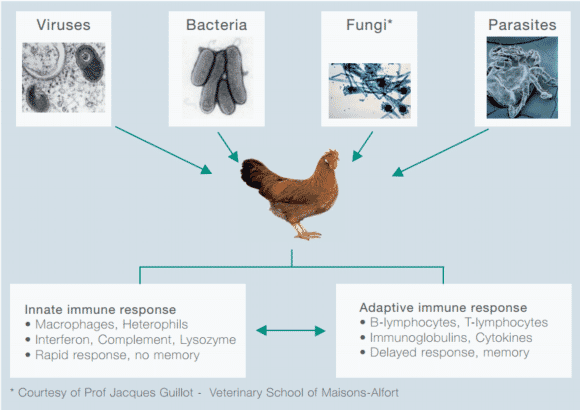For poultry, we often consider the needs of energy, protein, minerals and vitamins for production and health. When specifically feeding the immune system, we must first look at its unique requirements, although many key nutrients remain to be identified. We also must remember that the immune system consists of two different arms: the innate immune system and the adaptive immune system, both with different needs.

Image source: The Poultry Site
The innate immune system provides a first level of defense through physical barriers such as skin, mucosal membranes in the digestive tract, acids in the stomach, as well as specific chemical compounds such as cytokines, acute phase proteins and many others. See Alkie et al. 2019: Innate immunity development in embryo and early hatch; Ijaz et al. 2021: Innate Immunity and Salmonella
The innate immune system can prevent and resist certain levels of infection and is typically sufficient when animals are exposed to small amounts of pathogens; however, at a certain level of exposure, the innate immune system is overwhelmed, which leads to a more extensive disease development. During the innate immune response, poultry can have fever, develop disease-induced anorexia, have increased nutrient requirements, and show sickness behavior. For a summary see Sandberg et al. (2007).
Image Source: Ijaz et al 2021
A bird acquires immunity when it recognizes a new pathogen that is making it sick, and therefore is considered “pathogen-specific”. Through a complex process, which can take days or even weeks to establish, the bird produces antibodies specific to the pathogen with large-scale production of antibodies resulting in neutralization of the pathogen. This is referred to as ‘expression of immunity’ where immunological memory has been acquired and varies in time based on the type of pathogen.
The complex interaction between innate and acquired immunity for Influenza virus as described by Crisci et al. (2013).
This is a complex area of immunology, and an even newer area for immune nutrition; the immune system uses a plethora of different nutrients to ensure its correct function, including amino acids, fatty acids, vitamins, minerals, phytonutrients, and other yet-to-be-identified compounds. E.g. Wu et al. (2019).
Radzikowska et al (2019) provides a detailed and extensive review of the importance of fatty acid nutrition and the immune system. FURST PROTECT™ and FURST PROTECT DIRECT™ are critical dietary sources of such essential fatty acids.
